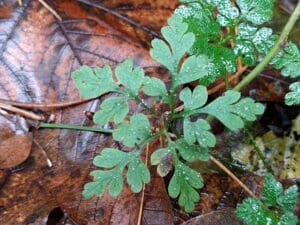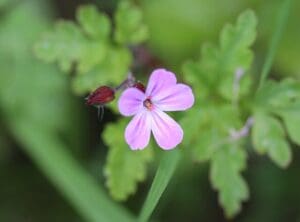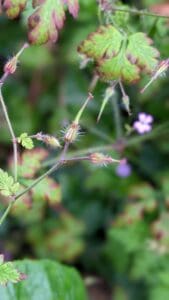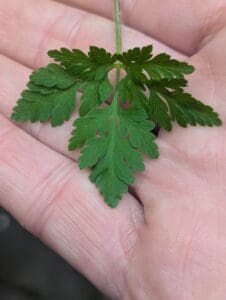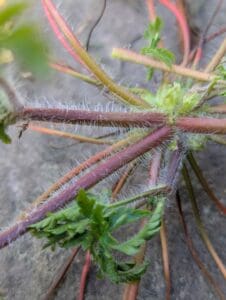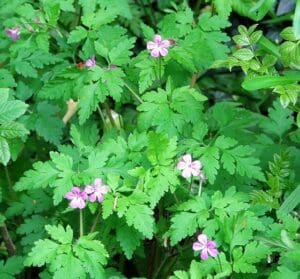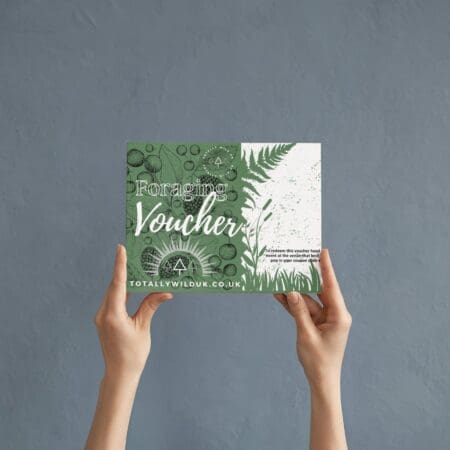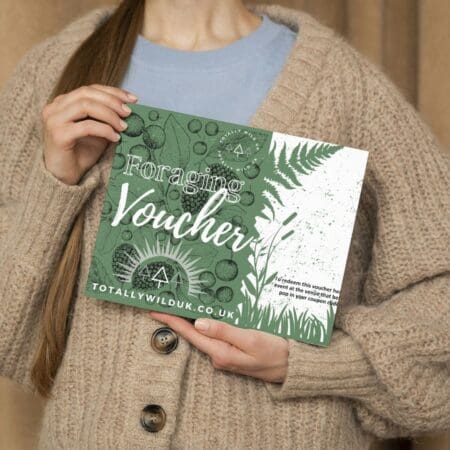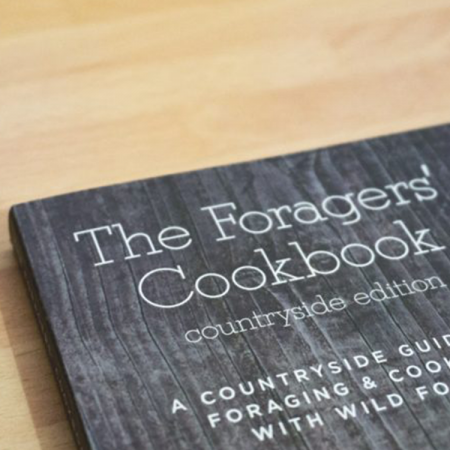Herb Robert / Spring / Summer / Autumn / Winter / Edible
Herb Robert (Geranium robertianum) is a small but striking wildflower commonly found in woodlands, hedgerows, and shady garden corners across the UK. With its bright pink, five-petalled flowers, reddish-tinged stems, and delicately divided leaves, it’s easy to spot once you know what to look for. One of its most distinctive features is its strong, musky scent—often described as unpleasant by some, yet historically valued in herbal medicine.
Traditionally, Herb Robert has been used for everything from wound healing to insect repellent, and it’s still appreciated today by herbalists and foragers for its potential immune-supporting properties.
In this post, we’ll show you how to identify Herb Robert, where it grows, and the folklore and practical uses behind this often-overlooked wild herb.
Common Names
Red robin, Death-comes-quickly, Stinking Bob, Squinter-pip, Storksbill, Fox geranium, Crow’s foot, Roberts geranium, St. Robert or St. Roberts Wort
Botanical Name
Geranium Robertianum
Scientific Classification
Kingdom – Plantae
Order – Geraniales
Family – Geraniaceae
Physical Characteristics for Herb Robert
Leaves
It starts off as a five lacy lobed leaf , on a long hairy stem coming from a rosette, but as it climbs up the stem you will also see them with just 3 lobes. They are bright green turning to darker green covered in fuzzy hairs. They often have a reddish tinge to them that gets more obvious with exposure to sun. Up to 6cm in size.
They also have a pungent smell to them that I have had compared to everything from a sweet parsley to coriander,soap and even fox urine! Everyone generally agrees the smell is obvious.
For me, I just think smelly, red/green, starfish!
Flowers
Attached to a greenish red stem covered in obvious hairs. It has star shaped with 5 bright pink/purple petals with white tints; as if painted with gentle brush strokes. They are around 1cm in size.
Seeds
They have seed capsules or ‘Fruits’ that are very hairy, green-red; they are obviously beaked (almost like a Hummingbird’s head), they are ridged and also hairy. About 1-2cm in length.
The seeds can travel over 20ft from the parent plant, survive travelling in rivers or streams to new areas, the hairs also can act like Velcro attaching itself to animals, insects and even humans.
The seeds can live without growing, just lying on the ground for over 6 years!
Roots
Very small in comparison to the plant size (about 30-40cm); they are thin, wispy and fibrous. Allowing them to grow in generally small, compact, inhospitable places.
Habitat
Woodlands, field edges, rocks and walls, gardens. It does prefer shady areas, however to be honest it will grow almost anywhere (as any gardener will tell you). It can be seen growing in pavements and walls in most urban places; I once saw it growing from the rear bumper of a bus!
Known Hazards
It is known for its antibiotic, antiviral and antioxidant properties. As a result this could change the viscosity of your blood if on blood thinners, so please consult your doctor before excess consumption.
There are no other known hazards associated with this plant other than the fact that it is more often than not viewed as a weed; therefore be mindful of where you pick this plant to avoid harmful chemical treatments.
Herb Robert Could be Confused with
This plant is very easily identified, however the flower can be very similar to that of other geranium species such as Hedgerow Cranesbill and Dove’s foot Cranesbill.
Always use the leaf characteristics to help you avoid confusion.
Again- Smelly, Red/Green, Starfish works best for me.
Edible Uses for Herb Robert
From an edibility point of view, it’s a bit of a Marmite plant; I know loads of people who enjoy it and lots that hate it! If you like the smell, give it a taste and see what you think.
The flowers make a lovely garnish onto savoury dishes, having a more perfumed flavour.
The leaves can be used in a variety of ways; within salads, as a herb used in the same way as coriander; it is lovely in flat breads/naans etc. It can also be used as a pot herb for soups and stews. It could be used in pesto and other sauces.
It also makes a lovely herbal tea used both dried and fresh.
Just remember to try it first as it often gets mixed reviews!
Notes on Herbal Uses of Herb Robert
In traditional herbal medicine this plant has been used for many ailments such as sore throats, stomach upsets; dysentery, toothache, headaches, improved liver function that was usually taken in the form of a tea or tincture.
It is said that this plant can be applied as a poultice to the skin to help heal wounds, skin conditions, to help to repel bugs such as mosquitoes, even being used for the treatment of nosebleeds as well as helping heal a variety of foot problems in the form of bath salts!
It has also shown promise in trials for the treatment of colitis, chronic fatigue, and cataracts. It contains compounds like germanium, which helps cells make oxygen available which is being explored as a treatment for cancer.
However there is insufficient evidence to suggest its usefulness in these ways.
Please always consult your doctor about medicinal uses.
Extra notes from the Foragers
The name “Herb Robert” may come from Saint Robert of Molesme, an 11th-century French monk and herbalist, who was renowned for using this plant to help locals with medical issues such as dysentery.
Other potential origins could come from its association with Robin Goodfellow also known as ‘Puck’ in English folklore. A mischievous nature spirit, and jester. He was famous for doing many domestic chores and services for families; this is believed to be where the Cockney slang ‘Thats Pucka’ meaning good comes from.
Be warned though; if he does not feel appreciated for his deeds though be sure to expect pranks and practical jokes, hence the ‘Horrid’ smell of this flower. The worst of his pranks was by way of a curse; If the plant is picked and taken into the home, a death will soon follow. A tad more than a prank if you ask me!
This goblin was the inspiration for Shakespeare’s character ‘Puck’ in A Midsummer Nights Dream!
For more on plants that you are likely to find in built up areas see;
https://totallywilduk.co.uk/2023/01/18/urban-foraging/
References
De, D. (2022). Knowledge to Forage.
https://www.rhs.org.uk/weeds/herb-robert
https://www.theforagingfoodie.co.uk/plants/herb-robert-geranium-robertianum/
https://www.first-nature.com/flowers/geranium-robertianum.php
https://kahikateafarm.co.nz/product/herb-robert/
https://www.webmd.com/vitamins/ai/ingredientmono-24/herb-robert
https://www.woodlandtrust.org.uk/trees-woods-and-wildlife/plants/wild-flowers/herb-robert/



